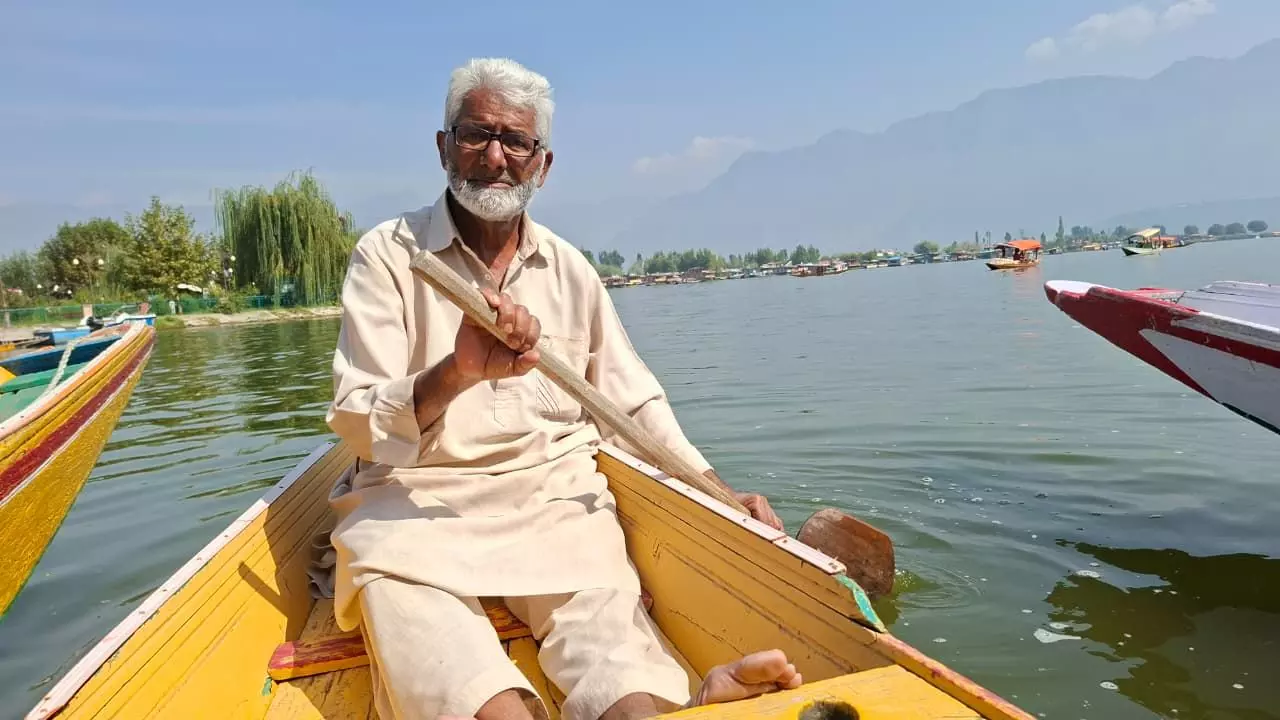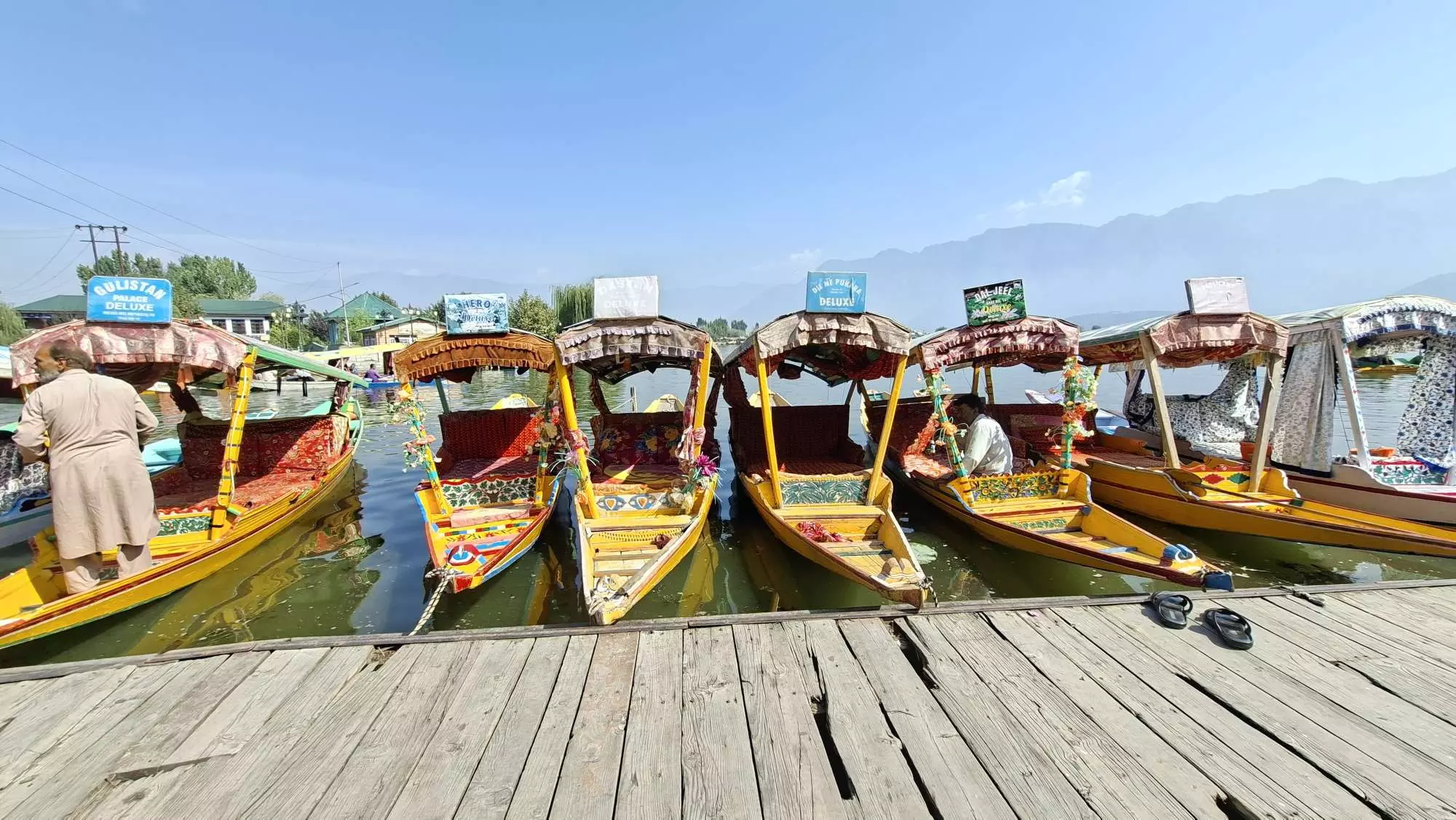
- Home
- India
- World
- Premium
- THE FEDERAL SPECIAL
- Analysis
- States
- Perspective
- Videos
- Sports
- Education
- Entertainment
- Elections
- Features
- Health
- Business
- Series
- In memoriam: Sheikh Mujibur Rahman
- Bishnoi's Men
- NEET TANGLE
- Economy Series
- Earth Day
- Kashmir’s Frozen Turbulence
- India@75
- The legend of Ramjanmabhoomi
- Liberalisation@30
- How to tame a dragon
- Celebrating biodiversity
- Farm Matters
- 50 days of solitude
- Bringing Migrants Home
- Budget 2020
- Jharkhand Votes
- The Federal Investigates
- The Federal Impact
- Vanishing Sand
- Gandhi @ 150
- Andhra Today
- Field report
- Operation Gulmarg
- Pandemic @1 Mn in India
- The Federal Year-End
- The Zero Year
- Science
- Brand studio
- Newsletter
- Elections 2024
- Events
Why Kashmir’s shikarawallahs are turning their backs on the lakes, taking up gig work
As tourism to Kashmir took a hit following the Pahalgam terror attack in April, among those to suffer are the shikara owners, whose modest earnings have left them without the safety net of savings to fall back on. Many have taken up odd jobs to support their families during this crisis

For months now, the splash of oars in Srinagar’s famed Dal and Nigeen lakes has been replaced by the quiet lapping of water against the sides of stationary shikaras — wooden boats that have for decades been an integral part of the tourism circuit in Kashmir. Where once the boats would busily ferry eager tourists across the lakes, or be used as floating shops to sell flowers and handicrafts...
For months now, the splash of oars in Srinagar’s famed Dal and Nigeen lakes has been replaced by the quiet lapping of water against the sides of stationary shikaras — wooden boats that have for decades been an integral part of the tourism circuit in Kashmir. Where once the boats would busily ferry eager tourists across the lakes, or be used as floating shops to sell flowers and handicrafts to visitors as they lazed on the shikaras, the shikaras now lie abandoned and desolate, anchored near the jetties and gathering moss.
As tourism to Kashmir took a hit following the Pahalgam terror attack in April this year, killing an estimated 26 civilians, among those to suffer the worst financial crisis are the shikara owners, whose modest earnings at the best of times have left them without the safety net of savings to fall back on.
"We have over 4,444 registered shikaras in Kashmir. Since the security incident in April, 95 per cent of our fleet has been completely idle,” said Wali Mohammad, president of the Shikara Association of Kashmir. The loss of income in the past few months — which included the peak tourism period in summer — has already caused many of these boatmen to look for alternate earning opportunities. "More than 600 shikarawallahs have taken up various kinds of temporary work because they were not earning even Rs 300 a day. When you cannot put food on the table for your children or pay their school fees, tradition and pride mean nothing. We were expecting a record year, and instead, we are rowing against a storm to survive,” Wali added.
According to official data, tourism contributes an estimated seven to eight per cent of Kashmir’s gross state domestic product (GSDP) — valued between Rs 18,500 and Rs 21,200 crore annually. The troubled area, which had for years grappled with the threat of terrorism and millitancy, had been showing a remarkable revival in tourism in recent years, as conditions somewhat stabilised. Domestic tourist footfall rose steadily from 25.1 lakh in 2020 to over 2.35 crore in 2024, while the number of foreign tourists coming to Jammu and Kashmir grew from just over 5,300 in 2020 to more than 65,000 in 2024. In the first half of 2025 alone, government data shows, Jammu & Kashmir recorded nearly 96 lakh domestic tourist visits and over 19,500 foreign tourist footfalls. However, the Pahalgam attack has again pushed those dependent on tourism for their livelihood into uncertainty, among them those operating shikaras, houseboats and hotels, as well as those working as guides and pony handlers.
One of those to look for alternate sources of income is 45-year-old Mohammed Rafiq Bhat, who has been rowing a shikara, ferrying tourists across Kashmir’s lakes, for the past 25 years. Before the Pahalgam attack scared tourists away from Kashmir, Bhat, the lone earner in a family of six, recalls making Rs 1,500-2,000 a day during peak tourist season — enough for the family to not only see through the month, but to also leave them just enough to tide over the lean winter months when tourists are fewer.
“But after the Pahalgam attack, I earned less than Rs 2,000 in the whole of May and June. We didn’t have enough for even a cup of tea for the family,” he rued. Moved to desperation, unable to pay the school fees for his kids, in June, Bhat made the agonising decision to moor his shikara and take to selling readymade garments at the local markets, earning Rs 600-700 on a good day.
The work is not just unfulfilling, but also a loss of identity for him, and other shikarawallahs like him, who have had to take up gig work to support their families during this bleak period.
For generations of Kashmirs, the shikara has been a cultural symbol of the place, often likened to the gondolas of Venice. More than just a mode of transport, the vibrantly painted, intricately carved boats reflect the unparalleled craftsmanship and artistic heritage of the region. Constructed typically from durable deodar wood, their design — featuring cushioned seating and canopies — showcases a blend of functionality and elegance. Serving as a water taxi, these boats serve to harvest aquatic vegetation in the Dal and Nigeen lakes, as well as act as floating markets for vendors selling flowers, vegetables and handicrafts to tourists and other locals, earning it the affectionate moniker "camel of Dal lake”. While the vast majority of commercial shikarawallahs who ferry tourists are men, women of the boatmen families are equally proficient in handling shikaras for personal and domestic use.
The boats are deeply woven into the fabric of Kashmir. While in the past, families would use a grand fleet of shikaras for wedding processions — the baraat — turning the water into a shimmering wedding aisle, in more recent years, they have also been used to host Republic Day and Independence Day rallies. Many of the shikara operators have been doing this for generations, taking pride in being a part of the region’s cultural identity. It is the loss of this identity that is a constant ache for those now doing odd jobs to support themselves and their families.
"My work was beautiful. It was an honour,” said Bhat of his life as a shikara operator. As he hawks garments at the market now, he is consumed by the fear of what might happen if tourism in Kashmir doesn’t pick up soon. “I would have to sell the wood [of the shikara] piece by piece. I would have to kill the boat to keep my children alive,” he added. For him, the shikara is almost a living entity, the loss of which would be as devastating for him as that of a dear friend or family member.

Nazir Ahmad waits for tourists in his shikara. Photo by Junaid Manzoor Dar
According to Wali, the making of a new shikara — the average life of a boat is about 30 years — is Rs 3.5-4 lakh.
Fifty-five-year-old Mohammad Ayoub had invested savings worth Rs 70,000 to upgrade his houseboat and shikara before the Pahalgam attack scared tourists away from Kashmir. Now, no longer able to afford even the basic essential maintenance oil for his boat's wood or to feed his family, Ayoub realised he was in no position to await the return of tourists to the Kashmir Valley. With a heavy heart, he turned his back on the lake and took to selling vegetables at Srinagar’s Hazratbal market, earning a meagre Rs 500 a day, on average.
"I used to be respected as a senior boatman, a host to all," he said bitterly, "Now I stand pushing a cart full of tomatoes.”
Also read: How online gambling ruined lives of young men in Maharashtra’s Solapur and Beed
The same story of loss and struggling to make ends meet is repeated by many other shikarawallahs.
While 37-year-old Zahoor Ahmad, a fourth-generation shikara operator who had been in the profession for the past two decades, has taken to working as a manual labourer at the Hazratbal market, Shahnawaz Ahmad, 45, a third-generation boatman, has traded tourists for vegetables, spices, and cigarettes, using his shikara to ferry merchandise to lake-side dwellers.
Waseem Ahmad Kulu, 44, shares a deep association with his shikara, dating back three decades, having started out as a helper to his father when he was just 15. But with tourism hit, he has been forced to work as a manual labourer at construction sites.
"My hands are for rowing and carving wood. Now they are cracked and hard from stone and sand. The exhaustion is so deep that when I get home, I can barely speak to my children, let alone help them with schoolwork. This construction work is saving us from starvation, but it is destroying the boatman inside me," he lamented.
The Federal reached out to director (tourism), Kashmir, Raja Maqbool, for comment on the tourism loss and plight of the shikarawallahs, but received no response. The article will be updated if a response is received. Meanwhile, an official in the department, speaking on condition of anonymity, admitted that ‘the tourism sector in Kashmir has been severely battered by the Pahalgam attack. Every segment of this industry — not just shikarawallahs — has suffered a deep blow”. He added, however, they “had seen a noticeable revival in the tourism sector since mid-August”. “The welfare of shikarawallahs is a priority for us, as their craft plays a vital role in attracting tourists and preserving the lake culture. "We are taking all necessary measures to support them alongside the broader revival of tourism," he added.

Shikaras anchored at the jetty. Photo by Junaid Manzoor Dar
Kashmir is no stranger to turmoil. In the 1990s and early 2000s, the then conflict-ridden state of Jammu and Kashmir (now bifurcated into the union territories of J&K and Ladakh) had also seen a decline in tourism. However, the shikarawallahs were already used to juggling other work with rowing a shikara at the time, said Wali. “Shikara rowing was always a traditional occupation, but families never depended on it entirely. They earned their living through small household businesses — selling handicrafts or local items from home. So, when tourism declined during those years, it affected us, but not as badly. This time, the situation is different — most families depend completely on tourism now, and that’s why the losses after the Pahalgam incident have been much harder to bear,” he explained.
For 65-year-old Nazir Ahmad, who has been rowing a shikara on the Dal Lake since 1975, the current economic loss is secondary in importance to the volatility that has shadowed the region for years. “India and Pakistan should talk and resolve issues. We locals suffer the most. In Kashmir, normalcy turns into abnormalcy within days, and it is the innocent people who bear the brunt,” he said.
Also read: How Makhana cultivation in Bihar leaves farmers struggling for survival
Added Shahnawaz: “My children ask why the lake is quiet. I tell them the boats are sleeping.”
It’s a slumber that he, and the other boatmen of Kashmir’s lakes, would hope ends soon, bringing back tourists and business to the Valley.
